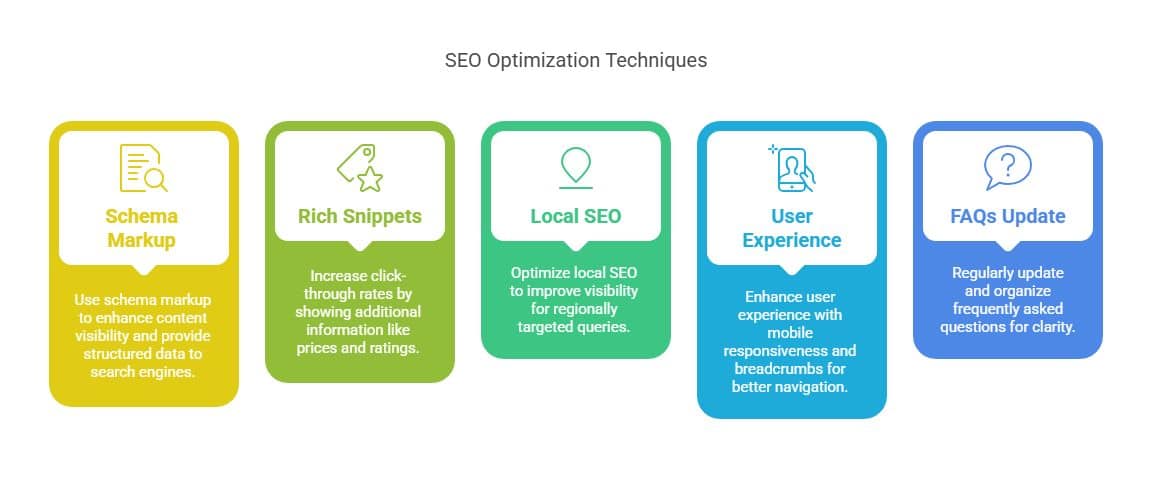
Enhancing SEO with structured data involves several strategic steps. Begin by utilizing rich snippets to increase search visibility and attract clicks. Incorporate breadcrumbs to improve navigation and user experience, which aids search engines in better indexing your site. Use the Knowledge Graph to elevate brand recognition. Optimize for local SEO to boost visibility in location-based searches. Enhance sitelinks to provide easy access to key site areas. Further, employ structured data in product listings, video content, and customer reviews to increase engagement and trust. Lastly, include well-structured FAQs to address common queries efficiently. These strategies pave the path to comprehensive SEO improvement. Discover the importance of structured data in SEO today!
Key Takeaways
- Use schema markup to improve content visibility and give search engines structured data.
- Increase click-through rates by displaying extra information, such as prices and ratings, using rich snippets.
- Improve visibility for queries that are regionally targeted by optimizing local SEO using structured data.
- Use mobile responsiveness and breadcrumbs to improve user experience, which will help with search ranking and navigation.
- Update and organize frequently asked questions using schema markup to increase user engagement and search visibility.

1. Rich Snippets: Grabbing Attention

A potent weapon in the SEO toolbox, rich snippets are intended to improve the visibility and attractiveness of your search engine results. Rich snippets give search engines a clear picture of the content on a webpage by utilizing schema markup, a structured type of data used to categorize and organize information. This improved comprehension enables search engines to display your material in search results in a more appealing and educational manner, drawing in more visits and increasing user engagement.
Employing rich snippets as part of your content strategy can significantly impact your website’s click through rate (CTR). When search results are adorned with additional information such as ratings, reviews, or product prices, users are more likely to perceive these results as relevant and trustworthy. This perception can lead to a higher CTR, as your content stands out amidst a sea of plain text links. Ultimately, this boost in CTR can translate into increased traffic and potentially higher conversion rates.
To effectively harness the benefits of rich snippets, it is essential to integrate schema markup into your website’s HTML. This integration requires careful planning and implementation within your content strategy, ensuring that the markup accurately reflects the information on your pages. By doing so, you optimize your content for search engines, making it easier for them to present your information in an engaging manner.
2. Breadcrumbs: Navigational Aid
Breadcrumbs often serve as an essential navigational aid for both users and search engines, enhancing the overall usability of a website. By providing a clear breadcrumb hierarchy, websites can improve user experience and facilitate a seamless navigation structure. This feature, typically displayed at the top of a webpage, allows users to trace their path within the website, thus understanding their location in the broader content organization. For search engines, breadcrumbs offer a structured path that aids in better indexing and understanding of the site’s layout.
Incorporating breadcrumbs into your website offers several benefits:
- Improved User Experience: Breadcrumbs help users identify their current position on the website and provide a quick way to navigate back to previous sections. This reduces the need for excessive clicking and improves overall satisfaction.
- Enhanced Search Engine Optimization: Search engines like Google utilize breadcrumbs to comprehend the context and hierarchy of pages within a website. This can lead to improved crawling efficiency and potentially better search rankings.
- Streamlined Content Organization: By defining a breadcrumb hierarchy, you establish a clear and logical structure for your content. This not only aids users but also assists search engines in understanding the relationships between different pages.
When implementing breadcrumbs, ensure they are consistent and reflect the actual navigation structure of your site. Avoid overly complex hierarchies that might confuse users or search engines. Instead, focus on simplicity and clarity to maximize the benefits of this navigational tool. By doing so, you create a more intuitive and user-friendly website, while simultaneously boosting your SEO efforts through structured data.
3. Knowledge Graph: Elevating Your Brand
Building on the foundation of effective navigation with breadcrumbs, the Knowledge Graph presents another powerful opportunity to enhance brand visibility and engagement in search engine results. The Knowledge Graph, a feature of Google Search, displays relevant information about entities such as people, places, and brands. By effectively leveraging it, businesses can solidify their brand identity while boosting search visibility.
To tap into the Knowledge Graph’s potential, businesses must focus on data optimization. Structured data plays a crucial role here, as it enables search engines to better understand the rich information about a brand. This understanding leads to a more prominent display of the brand’s data in the Knowledge Graph, directly influencing audience engagement.
| Strategy | Impact |
| Brand Identity | Enhances recognition and trust |
| Data Optimization | Improves search result accuracy |
| Content Strategy | Boosts engagement and visibility |
A well-defined content strategy is integral to this process. It involves crafting and organizing content that aligns with the brand’s identity and effectively communicates its value proposition. By doing so, businesses can ensure that their most pertinent information is showcased when users encounter the Knowledge Graph.
When executed thoughtfully, these efforts can lead to significant improvements in how a brand is perceived online. The resulting boost in search visibility not only attracts more visitors but also fosters deeper connections with the target audience. Ultimately, the Knowledge Graph is a vital tool in reinforcing a brand’s image and expanding its digital footprint, making it an indispensable component of any comprehensive SEO strategy.
4. Local SEO: Boosting Visibility

Local SEO can significantly ramp up a business’s visibility in search engine results, particularly for geographically-targeted queries. For local businesses, optimizing for local search is crucial to attract potential customers within their vicinity. By leveraging structured data, businesses can enhance their local SEO efforts in several ways.
- Citation Management: Consistent and accurate citations across various online directories and platforms are vital. Structured data aids in maintaining uniformity in business information such as name, address, and phone number (NAP). This consistency helps search engines verify the legitimacy of a local business, which can lead to improved search rankings. Implementing structured data ensures that search engines accurately comprehend the business’s details, thus reinforcing its online presence.
- Customer Engagement: Structured data can enrich local business listings by incorporating reviews and ratings. Online reviews are a powerful tool for customer engagement, as they provide potential customers with insights into others’ experiences. By marking up reviews with structured data, businesses can potentially display star ratings and review snippets in search results, making listings more attractive and encouraging higher click-through rates.
- Geo Targeting Strategies: Leveraging structured data to specify geographical parameters enhances geo targeting strategies. Incorporating location-based data allows search engines to better understand where a business operates, thus improving the chances of appearing in local search queries. This is especially important for businesses looking to capture a specific local market segment. By utilizing geographic markup, businesses can ensure they appear prominently in searches initiated by users in their target area.
5. Site Links: Enhanced Sitelinks

When users search for specific queries, one of the elements that can significantly enhance a website’s visibility and user experience is the presence of enhanced sitelinks. Sitelinks are additional links displayed beneath the main URL in search engine results, offering users direct access to various sections of a website. Implementing sitelink optimization effectively can lead to improved click-through rates, as users are quickly directed to the most relevant parts of a site.
To achieve this, it is essential to understand how search algorithms determine sitelinks. Typically, algorithms select sitelinks based on the site’s structure, popularity of pages, and the clarity of navigation. A well-structured website with clear headings and an intuitive layout is more likely to be rewarded with enhanced sitelinks. Consequently, conducting a competitive analysis of your site’s structure in comparison to industry leaders can provide insights into potential areas for improvement.
Moreover, user experience plays a pivotal role in sitelink optimization. Ensuring that your website is mobile responsive is crucial, as a significant portion of users access content via mobile devices. A seamless mobile experience not only satisfies user expectations but also aligns with search engine preferences, as mobile responsiveness is a key factor in ranking algorithms.
Incorporating structured data to better define the relationships between various components of your website can further aid search engines in generating relevant sitelinks. Ultimately, by focusing on sitelink optimization through competitive analysis and enhancing user experience, websites can secure a competitive edge in search engine results, driving greater visibility and user engagement.
6. Events and Courses: Attracting Participants

Attracting participants to events and courses requires a strategic approach that leverages structured data for enhanced online visibility. Structured data, when utilized effectively, can significantly boost event promotion and course offerings by making them more discoverable in search engine results. This is crucial in today’s digital landscape, where audience targeting and participant engagement are pivotal for successful online registration processes.
To optimize events and courses with structured data, consider these actionable steps:
- Implement Event Schema Markup: By integrating event schema markup, you increase the likelihood of your events appearing prominently in search results. This not only aids in event promotion but also enhances visibility, making it easier for potential participants to find and register for your events online.
- Utilize Course Schema Markup: For educational offerings, applying course schema markup can significantly augment the discoverability of your course offerings. This structured data helps search engines understand the content of your courses, thereby attracting the right audience who are actively searching for such educational opportunities.
- Focus on Rich Snippets: Rich snippets can display additional information such as dates, venues, and course durations directly in search results. This added detail can greatly enhance participant engagement by providing relevant information at a glance, encouraging users to click through for online registration.
7. Products: Driving Sales

Effectively leveraging structured data can frequently be the catalyst for driving product sales through enhanced online visibility and search engine optimization. By implementing structured data, businesses can provide search engines with detailed information about their products, such as product attributes like brand, model, price, availability, and reviews. This richness in data allows search engines to better understand and display products in a manner that attracts potential buyers.
Understanding consumer behavior is crucial, as structured data can align product listings with the specific needs and preferences of target audiences. By tailoring product attributes, businesses can influence the journey through sales funnels, ensuring that consumers receive relevant information that encourages purchasing decisions. Structured data aids in presenting critical product details in search results, which can directly impact click-through rates and conversions.
In addition, structured data facilitates more effective inventory management by allowing businesses to update product availability in real-time. This ensures that consumers are viewing up-to-date information, reducing instances of cart abandonment due to unavailable products. Moreover, structured data supports dynamic pricing strategies, providing the flexibility to adjust prices based on market trends and consumer demand.
8. Videos: Amplifying Engagement

How can businesses elevate their digital content strategy to captivate audiences? The answer lies in leveraging video content, which has become an indispensable tool for amplifying user engagement and enhancing SEO. Videos, when optimized correctly, not only enrich the user experience but also improve search engine ranking. Here are three key strategies that can help businesses effectively incorporate videos into their content strategy:
- Video Optimization: Ensure that videos are well-optimized for search engines. This involves using relevant keywords in titles, descriptions, and tags. Additionally, providing a transcript can make video content more accessible and indexable by search engines, boosting its discoverability.
- Audience Targeting: Tailor video content to meet the specific interests and needs of your target audience. Understanding the demographics, preferences, and behaviors of your audience allows for the creation of more relevant and engaging content. This targeted approach ensures that the videos resonate with viewers and encourage them to engage further with the brand.
- Analytics Tracking: Utilize analytics tools to track video performance and user engagement metrics. Monitoring these insights helps in understanding what content resonates most with the audience and informs future content strategies. Metrics such as view count, watch time, and user interaction can guide adjustments to optimize content delivery and increase viewer retention.
Incorporating these strategies into a comprehensive content strategy not only enhances user engagement but also positions videos as a powerful asset in achieving SEO goals. By focusing on video optimization, audience targeting, and analytics tracking, businesses can significantly amplify their digital presence and connect more effectively with their audience.
9. Reviews and Ratings: Building Trust

Customer feedback serves as a cornerstone in establishing credibility and trust in the digital marketplace. In the realm of SEO, user reviews and rating systems play a pivotal role in enhancing search visibility and fostering consumer confidence. The integration of structured data for reviews and ratings not only provides essential trust signals but also amplifies social proof. This, in turn, can significantly influence purchasing decisions and enhance brand reputation.
Incorporating structured data allows search engines to display rich snippets, which include star ratings and user reviews, directly in search results. This visual representation acts as a powerful trust signal, encouraging potential customers to engage with your content. The following table illustrates the emotional impact of reviews and ratings on consumer behavior:
| Emotion | Impact on Consumer Behavior |
| Trust | Increased likelihood of purchase |
| Confidence | Positive association with brand |
| Assurance | Higher engagement and loyalty |
A robust rating system, coupled with diverse customer feedback, provides a more comprehensive picture of product or service quality. By showcasing genuine user reviews, businesses can leverage social proof to differentiate themselves from competitors. This not only enhances the customer experience but also reinforces a brand’s authenticity and reliability.
To maximize the benefits of reviews and ratings, it is crucial to ensure that all customer feedback is genuine and transparent. Encourage satisfied customers to leave positive reviews and address any negative feedback constructively. By doing so, businesses can build lasting relationships with their audience, ultimately leading to improved SEO performance and increased trust in the brand.
10. FAQs: Providing Quick Answers

Frequently Asked Questions (FAQs) serve as a valuable resource in the digital landscape, offering quick and concise answers to common inquiries. By integrating an effective FAQ Strategy, businesses can enhance their content optimization efforts, aligning closely with user intent to improve overall search visibility. The use of structured data, particularly Schema Implementation, plays a crucial role in maximizing the impact of FAQs on SEO performance.
To effectively use FAQs for SEO, consider the following steps:
- Identify User Intent: Understanding what your audience is searching for is the cornerstone of an effective FAQ Strategy. Analyze search queries and customer feedback to determine the most pressing questions. This insight allows you to craft responses that address user needs directly, thereby improving engagement and satisfaction.
- Optimize Content: Once the key questions are identified, focus on content optimization by providing clear, concise, and relevant answers. Ensure that the language used is accessible and aligns with the common terms and phrases utilized by your audience. This approach not only enhances user experience but also improves the likelihood of your content being featured in search engine results.
- Implement Schema Markup: Utilizing Schema Implementation for your FAQ section is essential for boosting search visibility. Structured data enables search engines to better understand the content of your FAQs, potentially leading to rich snippets that appear prominently in search results. This visibility can significantly increase click-through rates and drive more traffic to your site.
Final Thoughts
Structured data is a powerful tool for enhancing SEO performance and improving user engagement. By effectively implementing structured data through rich snippets, breadcrumbs, and the Knowledge Graph, businesses can increase their visibility and appeal in search engine results. Additionally, optimizing for local SEO, incorporating sitelinks, and utilizing structured data in events, product listings, and reviews can significantly enhance the user experience and drive more traffic. Prioritizing structured data across all aspects of a website not only boosts search engine rankings but also builds trust and credibility with users, ultimately contributing to a successful SEO strategy.
Ready to optimize your website with powerful structured data strategies? Contact Syville Gacutan, an experienced SEO Specialist in the Philippines. Syville can help you enhance your search visibility, boost user engagement, and achieve sustainable SEO success. Connect today for expert guidance and proven SEO solutions!